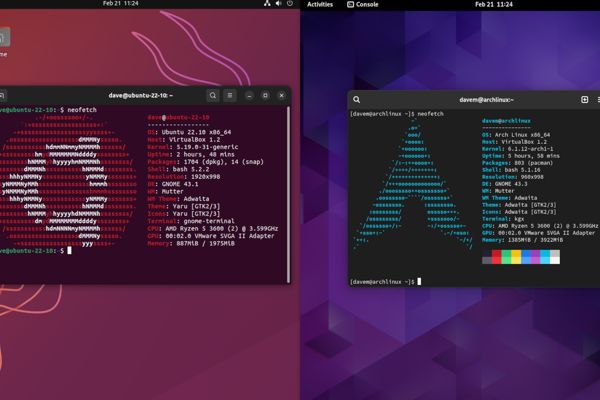
Linux Battle: Arch vs Ubuntu - Which Reigns Supreme?

Choosing the right Linux distribution can be daunting There are many options, but two of the most popular are Arch Linux and Ubuntu Both have passionate followers, but which one is better for you? We'll compare them on installation, hardware compatibility, available applications, package managers, and community support to help you decide
Ubuntu and Arch Linux are two popular choices for those looking to explore the world of Linux. While Ubuntu is often recommended for beginners, Arch is better suited for those with more experience and a willingness to put in the effort to customize their installation. Both have passionate supporters, so the decision ultimately comes down to personal preference and needs. If you're considering making the switch to Linux, there are many reasons to explore both Ubuntu and Arch, from the desire for open-source software to dissatisfaction with your current operating system.
Choosing to use Linux is a decision that often has clear reasons, but selecting a distribution can be a challenging task. While Ubuntu is frequently recommended for new users, others suggest starting with a distribution like Arch to gain a deeper understanding of Linux. Despite the belief that all distributions are essentially the same, utilizing the Linux kernel, GNU Core Utilities, a supported file system, a package manager, and preinstalled applications, the choice of which distribution to use is not straightforward.
Distributions go beyond just providing the basic Linux operating system. They offer unique features like personalized installation programs, exclusive software repositories, and desktop themes. Some distributions even develop their own desktop environment, such as the Cinnamon desktop created by Linux Mint. These variations among distributions can significantly impact the end user experience.
Arch Linux and Ubuntu Compared: an Overview
Arch Linux and Ubuntu are often seen as two extremes when it comes to the suitability for new Linux users. This is largely due to the different philosophies behind the two distributions. Arch is a community-driven project that is built entirely from scratch, while Ubuntu is produced by the Ubuntu Foundation and is based on Debian Linux. Arch aims to provide a lightweight and functional system that allows users to choose which packages they want to install, starting with a minimalist base.
Ubuntu is pre-loaded with a vast array of packages, ranging from office productivity suites and email clients to music players and more. However, this means that your computer may be filled with software that you may never use. Despite this, Ubuntu is designed to be user-friendly, with the company's former slogan being "Linux for human beings." Arch, on the other hand, is all about giving users full control. It won't install anything without your request, and it assumes that you know what you're doing. Canonical releases two versions of Ubuntu every year, in April and October, with every fourth release being a Long Term Support release that is supported and patched for five years. The interim releases receive support for nine months.
Arch Linux operates on a rolling release model, meaning that milestone releases are not a part of the system. Instead, users must install the latest Arch image and keep it up to date by frequently installing patches. These updates can occur multiple times a day, though most users tend to install them weekly or bi-weekly. While this system keeps the operating system current with new releases and upgrades, it can also be risky as faults can slip through the testing process. For example, a recent update to the GRUB bootloader caused thousands of Arch computers to boot into the BIOS instead of Arch Linux, requiring users to have knowledge and confidence in applying a workaround. Unlike Ubuntu, Arch requires users to have a basic understanding of Linux in order to successfully install and use the system.
How Installing Arch Linux and Ubuntu Differs
Ubuntu has a great GUI-based installation program. It steers you through the choices you need to make, picks sensible defaults for others, and leaves you with a complete, working system.
Installing Arch is a significantly more austere process than its counterparts. It operates through a terminal interface and requires multiple intricate steps. One of the more challenging aspects is configuring the Wi-Fi settings. The archinstall script offers slightly more assistance than the traditional method, but falls far short of the user-friendly experience provided by Ubuntu. While it does provide on-screen options for certain settings, selecting between them can still be confusing if you lack familiarity with their respective implications.
After successfully setting up your Arch Linux system, the next step is to install a desktop environment, like GNOME. In the past, the Arch Linux GUI project provided a basic version of Arch that was installed using the popular Calamares installer. However, the project has since been abandoned and no new ISO images will be released. While there are Arch-based distributions like Manjaro, ArcoLinux, Garuda, and EndeavourOS that offer GUI-based installations, they are not exact replicas of plain vanilla Arch. Although, EndeavourOS and ArcoLinux come very close to it.
Does One Have Better Hardware Compatibility?
Unlike Ubuntu, Arch only supports 64-bit x86 processors and lacks official ARM support. On the other hand, Ubuntu offers official support for a variety of computing platforms, such as the Raspberry Pi.
When it comes to resolving PC hardware compatibility issues, Ubuntu takes a proactive approach by identifying and including the necessary kernel modules and drivers. Arch, however, puts the responsibility on the user to handle these tasks.
When it comes to x86 PC hardware support, both distributions offer similar levels of support. However, Arch Linux may require a bit more effort on the user's part to set up. Installing and removing software packages is done through different command line tools, with Ubuntu using apt and Arch using pacman. Both distributions also have GUI-based alternatives available, such as the Ubuntu Software application and Arch's pamac.
What Applications and Package Managers Are Available?
Ubuntu users can also access additional software through specific Personal Package Archives, which are packages provided by private individuals. These can be installed using the standard apt tool. In contrast, Arch users have access to the Arch User Repository, which contains a vast collection of user-provided package descriptions. These packages can be downloaded and built on the user's computer using an AUR helper tool like yay or through pamac. While the official Ubuntu repositories have around 60,000 packages, the Arch repositories and AUR combined offer approximately 58,000 packages, but there are still more options available to users beyond these numbers.
Software packages that cater to multiple operating systems often provide different package formats for different Linux distributions. While Debian and Ubuntu-based systems can easily access a DEB package, Fedora and RedHat systems can make use of an RPM package. However, users of other Linux distributions may need to build the package from source by cloning the application's repository. As for Arch users, while it may require a bit more effort, it's still doable. Alternatively, you can opt for distribution-agnostic installation methods such as FlatPaks, Snaps, and AppImages, which may offer the package you're looking for.
What’s the Community Support Like?
Both Arch and Ubuntu users have access to a wealth of online resources for information and advice. One of the most valuable resources for Linux users is the ArchWiki, which offers concise information that is useful for users of all distributions. However, the brevity of the information can be overwhelming for newcomers and the Wiki provides a guide for reading it. Additionally, both Ubuntu and Arch have unofficial subreddits that are friendly and offer helpful resources.















